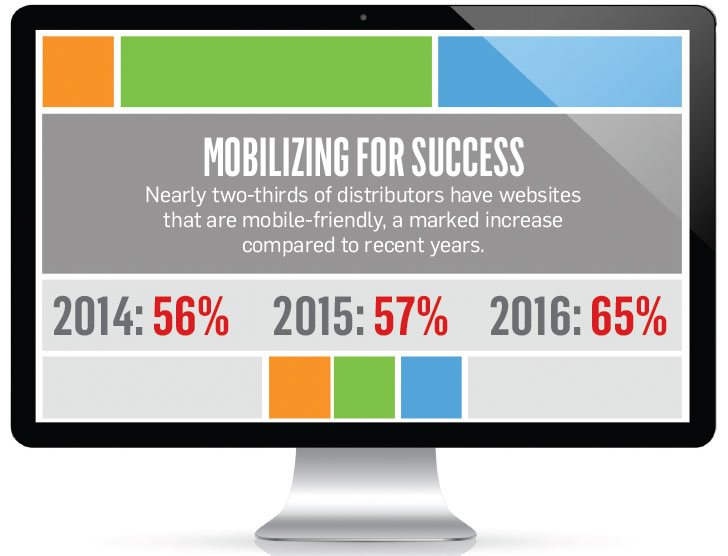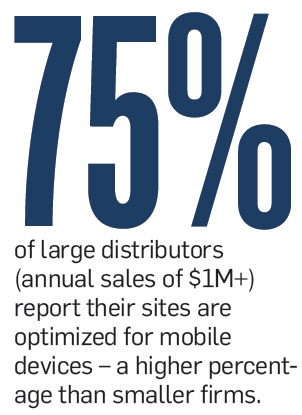July 19, 2017
Why Your Website Should be Mobile-Friendly
A growing number of distributors now offer a mobile-friendly version of their site. Here’s why you should too.
Mobile-friendly versions of desktop websites have gone from a convenient add-on to a must-have for most distributors. In fact, 65% of distributors now have mobile-friendly sites, an 8% increase compared to 2015.
It’s easy to understand why.
>>Back to the State of the Industry 2017
“The stats all prove that people are using their smartphones and tablets in ways that we’ve never seen before. As a result, potential customers are far more likely to use their mobile device to do research than waiting to access a computer,” says Scott Gingold, president of Greater Business Solutions.

John Booth, president of Quintain Marketing (asi/303131), says his company has had a mobile-friendly site for several years, but the Maryland-based firm has taken it to a new level in the last year with a mobile-first approach.
“We looked at analytics – specifically, the devices that our visitors were using when they came to our site – and saw dramatic growth in mobile visits,” he says. “Our expectation is that this trend will continue, and in the next two years, the clear majority of our visitors will be using mobile devices. For this reason, we think it’s important to design primarily with mobile and not desktop users in mind.”
Since Quintain implemented its mobile-first approach, the firm has seen consistent improvements in its marketing results, which Booth attributes to the site redesign, along with ongoing updates and improvements to the site since the launch.
“We believe strongly that website redesigns can’t be treated as a project with a beginning and an end date,” Booth says. “The internet is changing so quickly, as is mobile technology, and to maintain a peak-performing website, you need to approach it as a data-driven process of continuous improvement.”
Booth believes that firms can’t afford to go a year or more between updates to their website. “We look at our site performance on a weekly and monthly basis and are constantly making changes to improve visitor conversion rates, reduce bounce rates, etc.,” he says.
Quintain also offers website redesign as an added service, making this consistent implementation an easier process. But for those who don’t specialize in internet design, Gingold notes a number of web hosts offer simple build-it-yourself mobile templates that range from $10-$30 per month. “Most of these sites can bet set up in two to three hours, especially if they keep them simple,” Gingold says.
Michael Shein, president of Polar Promotions (asi/138454), says his company has used a mobile-services provider for three-plus years. He estimates the price of setup to be a one-time cost of $3,000, with no monthly fees. “We wanted our customers to be able to place orders via their phones – easy for them and a value-added feature we could sell,” he says. “Our customers love the convenience of our mobile sites.”
Polar has increased its sales by 113% over the past three years, and while Shein says his firm’s move to mobile isn’t entirely responsible for the uptick, it certainly hasn’t hurt. When building a mobile-friendly site, Gingold thinks simple is better. “Remember: We are appealing to people on their mobile devices, so brevity and getting to the point is critical,” he says.

Gingold also believes distributors should ask themselves what they like when they visit mobile-friendly sites, and include those elements on their own versions. “When I see a phone number and click on it, it should invoke the dialer on my phone. Same thing for email and social media links,” he says. “If there is a brick-and-mortar location, there should be a Google map that allows you to easily get driving directions.”
Gingold recommends including hours of operation and timely specials on a mobile version as well, and he notes it’s crucial to update the site often. “Give the visitor a compelling reason to revisit the site and recommend it to others,” he says.
Quintain uses historical data from Google Analytics, along with user behavior through a tool called Hotjar that allows the firm to see two key things: recordings of individual user sessions and heat maps that show how far people scroll and where they click on both the mobile and desktop version of the site. “With this data, we can determine how a site should be structured so it offers mobile visitors the best user experience,” Booth says.
Booth believes mobile-friendly sites have become an essential marketing tool for a customer base that’s doing more and more shopping from phones and tablets rather than PCs and laptops. “Your company’s website should be your most productive marketing and sales asset. Yes, many businesses still grow by word-of-mouth and referrals, but that group of buyers is shrinking,” he says. “When companies like Netflix suggest movies based on your likes and dislikes, and Amazon does the same with product suggestions, they raise the customer’s expectation for all of us – distributors included.”